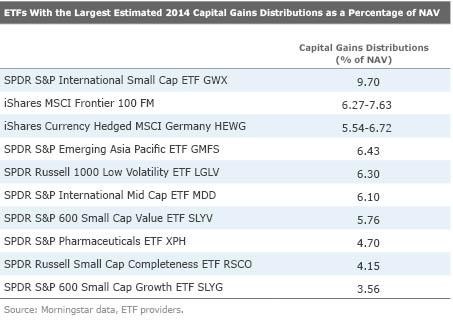Capital gains distribution
Post on: 10 Июнь, 2015 No Comment

From Bogleheads
A capital gains distribution occurs when mutual funds. closed-end funds. and exchange-traded funds (ETFs) make distributions to shareholders from the capital gains realized in their investment portfolios. For investors holding funds in taxable accounts, these distributions are taxable, the rate of taxation dependent on how long the fund has held the investment and the individual taxpayer’s marginal tax rate. The two types of distributions that apply to stock and bond funds are termed short-term gains and long-term gains. [note 1]
- Short-term capital gains distributions are made from realized gains on securities held for one year or less. Short-term gains are taxed at ordinary income tax rates Short-term gain distributions are included in a fund’s ordinary dividend distribution; therefore, capital losses may not be subtracted from these distributions when computing taxes.
- Long-term capital gains distributions are made from realized gains on securities held for more than one year. They are reported on tax Schedule D along with any other capital gains, and can be reduced by capital losses.
Tax rates in 2012
For the tax year 2012, short-term gains are taxed at ordinary income tax rates up to 35%.
Long-term gains are taxed at 0% for taxpayers in the 10% and 15% tax brackets and at 15% for taxpayers in the 25%, 28%, 33%, and 35% tax brackets.
Tax rates in 2013 and beyond
For the tax year 2013, and for subsequent years, short-term gains are taxed at ordinary income tax rates up to 39.6%. For taxpayer’s subject to the Net Investment Income (NII) tax, a 3.8% surtax for taxpayers whose adjusted gross income surpasses threshold limits, [note 2] the maximum tax rate will increase to 43.4%.
The taxation of long term capital gains also changes beginning in 2013. Long-term gains are taxed at 0% for taxpayers in the 10% and 15% tax brackets and at 15% for taxpayers in the 25%, 28%, 33%, and 35% tax brackets. For tax payers in the 39.6% marginal tax bracket, the capital gains tax is 20%. For taxpayers subject to the Net Investment Income (NII) tax, the capital gains tax increases to 18.8% and 23.8%.
The NNI tax threshold levels begin to effect taxpayers whose adjusted gross income falls in the 33% marginal tax bracket, and affects taxpayer’s in the 35% and 39.6% marginal tax brackets.
Federal Capital Gains and Dividend Taxation in the United States from 2008 forward [1]














